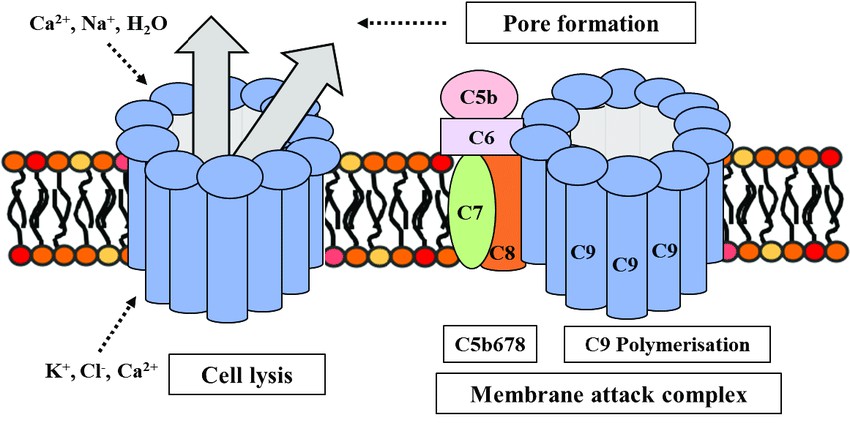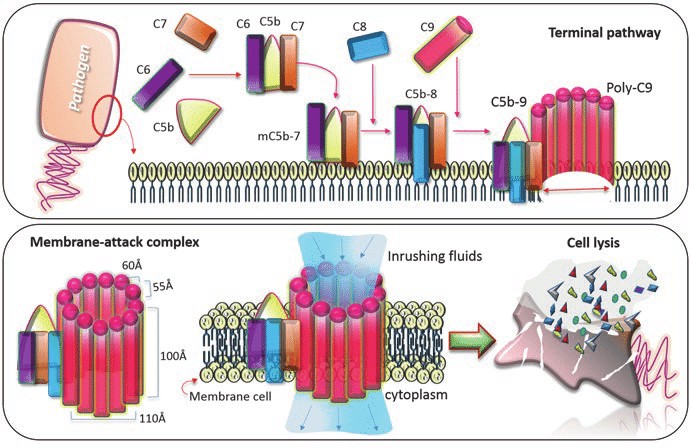Membrane Attack Complex (MAC)
About Membrane Attack Complex (MAC)
The membrane attack complex (MAC) is a multi-protein complex formed as the final step of the complement cascade, a critical component of the innate immune system. The MAC plays a key role in the immune response by directly lysing and destroying target cells, particularly those of pathogens.
The MAC is typically formed on the surface of a target cell when complement activation proceeds through the classical, lectin, or alternative pathways. This complex consists of several complement proteins that assemble into a pore-like structure on the cell membrane. The primary constituents of the MAC include C5, C6, C7, C8, and C9.
The formation of the MAC occurs in a sequential manner. Here is a general overview of the steps involved:
- Activation of the Complement Cascade: The complement cascade is activated through one of the three pathways: classical, lectin, or alternative. Activation leads to the generation of C3 and C5 convertases, which cleave C3 and C5, respectively.
- Assembly of the MAC: The formation of the MAC begins with the cleavage of C5 into C5a and C5b. C5b then binds to the target cell surface. Subsequently, C6 binds to C5b, followed by C7, forming a C5b-7 complex. This complex acts as a receptor for C8, which binds and recruits multiple C8 molecules to the site.
- Insertion of C9 and Pore Formation: The recruitment of C9 is a crucial step in MAC assembly. Multiple C9 molecules bind to the C5b-8 complex, forming a polymerized structure. These polymerized C9 molecules then insert into the target cell membrane, creating a channel-like pore.
Membrane Lysis and Cell Death: The formation of the MAC pore disrupts the integrity of the target cell membrane. It leads to the influx of ions and water into the cell, resulting in osmotic lysis and cell death. The lysis of target cells by the MAC facilitates the elimination of pathogens, damaged cells, and other foreign particles.
It's important to note that the MAC has the potential to cause damage to host cells as well. However, complement regulatory proteins, such as CD59, help protect host cells by preventing the assembly and insertion of C9 into the MAC. This regulation helps maintain the delicate balance between immune defense and self-tolerance.
 Fig. 1 Membrane attack complex (MAC formation). (Swarnima Bahadur, 2023)
Fig. 1 Membrane attack complex (MAC formation). (Swarnima Bahadur, 2023)
This figure shows the activation of terminal components of the complement C5b, C6, C7, C8 and C9 which results in the deposition of MAC onto the plasma membrane of the target cells. This causes pore formation in the membrane preventing target cells from maintain osmosis and electrolyte imbalance and results in their death.
The membrane attack complex is a powerful effector mechanism of the complement system, contributing to the host's defense against pathogens. Its ability to directly lyse target cells provides a rapid and effective means of eliminating threats. Understanding the assembly and regulation of the MAC is crucial for comprehending the pathophysiology of complement-related diseases and developing targeted therapies.
Physiological Functions of Membrane Attack Complex (MAC)
Pathogen Destruction: MAC is a highly efficient mechanism for the direct killing of pathogens. It targets a wide range of microorganisms, including bacteria, viruses, fungi, and parasites. MAC forms a ring-shaped structure on the surface of the pathogen and creates pores in its membrane. These pores disrupt the membrane integrity, causing leakage of cellular contents, loss of osmotic balance, and ultimately leading to pathogen death.
Clearance of Cellular Debris: The MAC is involved in the clearance of cellular debris, such as apoptotic cells and cellular fragments. When cells undergo programmed cell death (apoptosis), they generate "eat me" signals that attract phagocytes for their removal. The MAC can be locally generated on apoptotic cells, facilitating their recognition and engulfment by phagocytes, thus promoting the efficient clearance of cellular debris.
Tissue Remodeling and Regeneration: MAC can induce cellular responses, including the release of cytokines and growth factors, which promote tissue repair and regeneration. The MAC's role in tissue remodeling is particularly relevant in the context of wound healing and tissue regeneration after injury or infection.
Inflammation Modulation: MAC can stimulate the release of various cytokines, chemokines, and other inflammatory mediators. MAC complexes can directly activate immune cells, such as mast cells and macrophages, leading to the release of pro-inflammatory substances. This can trigger localized inflammation, attracting more immune cells to the site of infection and promoting an enhanced immune response.
Tumor Cell Killing: When exposed to MAC, tumor cells undergo cell death through mechanisms similar to those seen in pathogen killing. The formation of MAC pores in tumor cell membranes disrupts their integrity and triggers an apoptotic pathway, leading to tumor cell death. Therefore, MAC plays a role in anti-tumor immunity.
Complement Regulation and Homeostasis: While the MAC itself is a powerful effector of the complement system, its formation is tightly regulated to prevent damage to host cells. Complement regulatory proteins, such as CD59, inhibit the assembly and insertion of C9 into the MAC on host cells, protecting them from complement-mediated lysis. This regulation helps maintain complement homeostasis and prevents excessive complement activation.
 Fig. 2 Membrane attack complex (MAC) formation and the resultant consequences in target cell. (Andrade FA, et al., 2017)
Fig. 2 Membrane attack complex (MAC) formation and the resultant consequences in target cell. (Andrade FA, et al., 2017)
Newly formed C5b reacts with C6 to form the stable C5b6 complex. Binding of C7 results in a hydrophobic complex that targets the membrane (mC5b-7). Membrane insertion is initiated upon binding of C8 (C5b-8) after which 12–18 copies of C9 polymerize to form the pore-forming ring structure to induce lysis of microbial membranes
Available Resources for Membrane Attack Complex (MAC)
Creative BioMart is dedicated to supporting scientific researchers by offering a comprehensive range of products and customized services about the MAC. The products include recombinant proteins and others. We have curated a vast array of resources on the MAC, encompassing pathways involved, protein functions, interacting proteins, relevant articles, research areas, and associated topics. Whether you seek insights into the regulatory mechanisms and pathways of MAC or wish to comprehend its functions and roles in diverse biological processes, we are equipped to fulfill your requirements.
Our Featured Products
Active Recombinant Human C5 protein
Recombinant Human C5, His-tagged
Recombinant Human C6, GST-tagged
Recombinant Human C6 protein, His/T7-tagged
Recombinant Human C5AR1, His-tagged
Recombinant Human C7 protein, His-tagged
Recombinant Human C9, GST-tagged
Recombinant Human CD59, His tagged
Our abundant resources and personalized services unite to advance MAC research, let us contribute to unraveling the intricacies of the MAC, and drive scientific progress. If you have any questions, requirements, or cooperation intentions, please feel free to contact us. We very much look forward to working with you and helping you achieve research and commercial success.
References:
- Doorduijn DJ, Rooijakkers SHM, Heesterbeek DAC. How the Membrane Attack Complex Damages the Bacterial Cell Envelope and Kills Gram-Negative Bacteria. Bioessays. 2019;41(10):e1900074. doi:10.1002/bies.201900074.
- Swarnima Bahadur. A study of different types of interpolating polynomials and their convergence behaviour on non-uniformly distributed set of nodes on the unit circle. April 2023. DOI:10.13140/RG.2.2.26547.71202
- Andrade FA, Lidani KCF, Catarino SJ, Messias-Reason IJ. Serine Proteases in the Lectin Pathway of the Complement System. Proteases in Physiology and Pathology. 2017 Jun 10:397–420.


